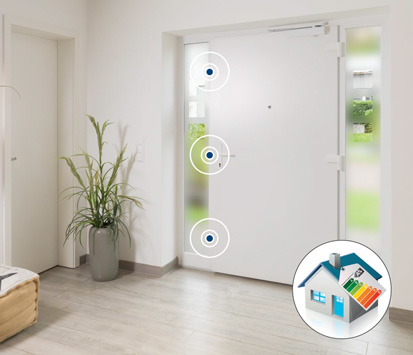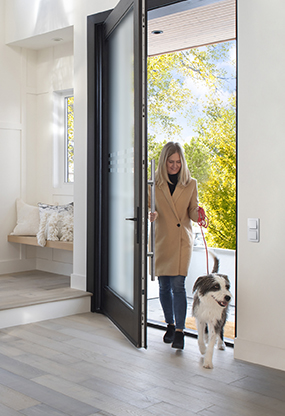Know-how
Save energy with modern door systems
scroll down
Increase security and save energy
The front door is the visual focal point of every residential building. But as the main entrance, it has its weak spots – and not just for burglars. If the front door is not properly sealed or insulated, it can let damp, cold, heat and noise into your home. Modern door systems not only provide more protection against break-ins, they also ensure that heat stays in your home so you don’t lose valuable energy.
How do modern door systems help to save energy?
Modern door systems are not just there to look pretty. They can also play a key role when it comes to security and energy efficiency. Renovation measures to increase energy efficiency are often only concerned with insulating the building shell or modernising windows. However, we shouldn’t underestimate the power of the front door when it comes to a building’s energy balance.
A seal-tight door and avoidance of heat bridges are both crucial for heat insulation. The German Energy Saving Ordinance (EnEV) requires U-values for new front doors: this heat transfer coefficient (U-value) is stated in W/m²K (watt per square metre and kelvin). It shows how much heat escapes through the door. The regulation for installing front doors stipulates that: “When upgrading entrance doors, only doors with a door surface that does not exceed a heat transfer coefficient of 1.8 W/m²K may be used.” Using the incorrect material or insufficient sealing of the front door can negatively impact the building’s energy values.
The U-value and the used material’s insulating properties both depend on the dimensions of the door and profile depth. It was previously customary for door systems to use profile depths of 70 mm for aluminium and 90 mm for plastic doors, resulting in a U-value of up to 4.8 W/m²K. New aluminium door systems now achieve a value of 0.45 W/m²K thanks to improved insulation with several sealing layers and an increased depth of more than 100 mm.
A multipoint locking system is absolutely crucial for optimum seal tightness for closed doors. These lock the front door at multiple points to ensure constant, effective contact pressure. This, in turn, permanently prevents door warping and guarantees long-lasting seal tightness. This means that heat stays in the home, conditioned air doesn’t escape and outside noise is effectively blocked out, resulting in a comfortable indoor climate and reduced energy costs.

How efficient is my building?
The blower door measurement is a measure of pressure difference that simulates wind load on a building on a stormy autumn day at a wind strength of 5. This so-called blower door test quantitatively measures the air tightness of a heated building, determining how often the building’s air volume is exchanged with the outside air at a certain pressure difference per hour. To create this pressure difference evenly, a ventilator is used in a building opening (window or entrance door).
The measurement standard reference changed when the German Building Energy Act (GEG) entered into force on 1 November 2020. According to the previous law (German Energy Saving Ordinance = EnEV), blower door measurements were carried out in accordance with DIN EN 13829. The new law stipulates that they must be carried out in accordance with DIN EN ISO 9972.
A permanently installed and configured entrance door must be available for the measurement. All windows, entrance doors and hatches for the enclosed space of the building being tested must be closed. Openings in the building shell that are not intended as ventilation must be closed (e.g. letterboxes built into the entrance door).
This test is a measure for
- Reducing heating costs
- Avoiding infiltration heat loss
- Avoiding building damage through condensation build-up
- Avoiding mould
- Ensuring optimum function of any ventilation systems with heat recovery
- Improving indoor climate by:
- Increasing air quality
- Avoiding draughts
- Avoiding cold air streams
- Improving soundproofing
Want to make your front door more energy efficient?
Ask your local installer or component retailer about FUHR locking systems. You can find our specialist partners, along with answers to your questions about our locking systems, here:
Funding for energy-efficient construction and renovation
The “Federal Funding for Efficient Buildings (BEG)” initiative has been created by KfW Bank as part of the 2030 climate protection programme. Through energy savings, combined with the use of renewable energies, this funding aims to help reduce the primary energy demand from buildings. It is available for all residential buildings (e.g. condominiums, single-family homes, shared buildings and residential hostels) and all non-residential buildings (e.g. commercial buildings, communal buildings and hospitals).
There are various funding options available for private persons looking to make their residential building more energy-efficient. Depending on the type of renovation project, funding can be provided as an investment subsidy by the Federal Office of Economics and Export Control (BAFA) or in the form of a promotional loan with repayment subsidy from KfW Bank.
Before applying, interested parties should determine whether the project involves complete renovation resulting in a Effizienzhaus standard as outlined by the KfW, or individual measures to improve energy efficiency. They should also outline concrete measures in relation to the building shell and system technology planned as part of the renovation. Potential applicants must also specify whether these measures will be implemented using their own capital or a loan. Answering these questions will help to determine where to apply. Funding must be applied for prior to starting construction. Funding can also be requested for any consultation, planning and installation in addition to the measures themselves. Interested parties must use the services of energy efficiency experts to apply for BEG funding.
Those looking to permanently reduce energy costs and protect the climate can find all the information they need on funding by KfW Bank here.





